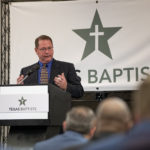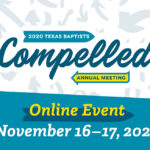MARSHALL—A commitment to truth-telling requires Southern Baptists to reckon with the whole truth of their past—racism and all, church historian Carol Holcomb said.
Holcomb, professor of church history and Baptist studies at the University of Mary Hardin-Baylor delivered the William M. Pinson Baptist History Lecture at East Texas Baptist University.
“Big-picture” narratives that tell stories of the past from the perspective of people in power offer only a one-dimensional view of history, Holcomb asserted in a chapel address to students.
“Telling the truth means that we need more than one picture, more than one angle,” she said. However, we often prefer a sanitized and selective view of history that ignores unpleasant truth, she added.
“We frame things in ways that leave out the things we do not want to see or examine,” she said.
As surely as a theologian must tell the truth about God and a biblical scholar must tell the truth about Scripture, a historian must tell the truth about the past, she insisted.
“Truth telling is at the heart of every discipline in religious studies—a sacred calling, a holy exercise,” she said. “We have this great cloud of witnesses that have gone before us, and historians must honor their stories with truth.”
Competing historical narratives
As an example, Holcomb told two stories about how Baptists in the South formed a publishing house in the decades after the Civil War.
The official history traditionally taught in Baptist history classes focuses on two individuals. J.M. Frost promoted the idea of a denominational publishing house specifically for Southern Baptists. J.B. Gambrell feared a centralized publishing house would give denominational leaders too much control over local churches.
Sign up for our weekly edition and get all our headlines in your inbox on Thursdays
So, at the end of a Southern Baptist Convention annual meeting, leaders of the convention put Frost and Gambrell in the same room and told them to work out their differences.
Ultimately, Gambrell agreed to let Frost write a proposal for a new publishing house on the condition that Gambrell would write the last paragraph. Frost agreed to let Gambrell write the last paragraph if he—Frost—could add the last sentence.
Frost wrote a strong argument in favor of a denominational publishing house. Gambrell, in turn, added the paragraph insisting congregations have “fullest freedom of choice” about whether to buy and use the literature.
Consequently, the SBC in 1891 established the Baptist Sunday School Board, now known as Lifeway Christian Resources.
“It is a great story of cooperation and statesmanship. But there is another angle to this story,” Holcomb emphasized.
Ignoring uncomfortable truth
In 1889, Baptists in the North—who published the literature Southern Baptists had been relying upon—announced three influential Black pastors would write articles for the 1890 issue of the Baptist Teacher. Walter Henderson Brooks, Emanuel Love and William James Simmons were assigned articles on “The Doctrine of God,” “Regeneration” and “The Lord’s Supper.”
Frost and other SBC leaders voiced their opposition, because the three Black pastors were outspoken critics of racial violence and white supremacy, Holcomb noted.
“Under pressure, the Northern Baptist magazine withdrew its offer to Brooks, Love and Simmons, which did little to mollify anyone involved. Southern Baptists used the event to gain support for a distinctly “Southern” religious press—a press that would not challenge the assumptions of white supremacy,” Holcomb said. “Black Baptists viewed the decision as yet one more chapter in an endless tale of betrayal.”
Both versions of the story of the publishing house’s formation—the narrative focused on cooperation and the one that reveals racism—are “absolutely true,” she noted. But the former “ignores the uncomfortable, messy racial tensions that shaped the culture of the 1890s,” she added.
“White Southern Baptist historians who recorded the origins of the Sunday School Board wanted to celebrate their denomination without alienating their white audience,” she said. “The pictures they took of Baptist history became tradition, and things outside the frame were forgotten.”
Southern women slow to address race
Holcomb acknowledged she was slow to recognize “the elephant in the room”—race—early in own her studies as a church historian.
In part, she said, it was because she was focused on another group historians had ignored—women. And for the most part, Southern white women in that time failed to address the issue of race.
“Do you know you can read the letters of white Southern Baptist women—reams of them, entire archives full of them, without encountering any in-depth discussion of race? It was not only an invisible elephant in my classrooms during the 1980s; it was invisible in the primary sources of 100 years before,” she said.
In reading “piles of letters” by white Southern Baptist women, Holcomb found only one reference to lynching—a letter in which missions legend Annie Armstrong insisted northerners could not hold “Christian people of the South accountable for lynchings.”
Five years earlier, investigative journalist Ida B. Wells documented lynching as “a widespread practice used to intimidate and terrorize African Americans in the South who presented economic or political competition to the white establishment,” she noted.
However, Armstrong remained blind to the prevalence of lynching.
“Armstrong dismissed any idea that lynching was a systemic problem,” Holcomb observed. “To Armstrong, lynching was a regrettable, rare event carried out by a few bad actors in society. Good Christian people were not involved. … For all her wonderful contributions to Baptist missions, Annie Armstrong’s portrait of the South had gaping holes in it.”
The writings of Black Baptist women such as Nannie Helen Burroughs and Virginia Broughton—offered a richer and fuller view of Baptist history, Holcomb noted. However, she acknowledged gaps and blind spots remain in her perspective.
“You see, the truth of history—like the truth of the gospel—is bigger than we can possibly imagine. The more truth we uncover, the more pictures we take, the clearer the past will become,” Holcomb said.
“We cannot be afraid of the truth. We cannot shrink from the truth—even when it paints us in a negative light, even when it reveals things that we would rather not see.”
‘Convicting us with the truth’

During a luncheon for faculty and guests, Holcomb further explored the relationship between Black and white Baptist women in the South. Through cooperation in missions, some white Baptist women in the South began to question their assumptions about race and participate in limited programs of racial reform, she noted. However, she characterized them as “unreliable allies” in the battle for racial justice.
At the luncheon, ETBU President J. Blair Blackburn thanked Holcomb for “having the courage to boldly confront the history of racism in Southern Baptist life.”
“I admire your candidness to clearly identify the absence of women’s voices as well as the voices of Black men and women, and their contributions to Baptist life—church, missions, education and civil rights,” he said.
“To tell the truth of history is difficult because it creates conflict. It reveals the pain and agony that too many in our country have faced. Thank you for convicting us with the truth through your remarkable Christian scholarship and study.”















We seek to connect God’s story and God’s people around the world. To learn more about God’s story, click here.
Send comments and feedback to Eric Black, our editor. For comments to be published, please specify “letter to the editor.” Maximum length for publication is 300 words.